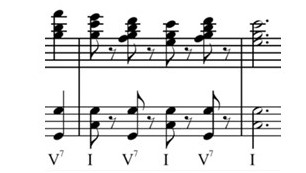Yes, it's about the minor second ("half step") movement.
The progression can be generalized in terms of root progression and voice leading: root progression by descending perfect fifth, and voice leading of one voice held and two voices moving by step.
In the diatonic gamut that only happens in two places: Vb I and Ib IV. (b means first inversion.) There is a sort of equivalence in those two progressions in terms of root progression and voice leading. In a purely diatonic context the two can be distinguished by making V a dominant seventh chord, like V7b I. You cannot do the same diatonically moving to IV and the added seventh in V7b provides two minor-second motions resolving to I in TI DO and FA MI.
It's interesting to compare these progressions with some other progressions that also have the voice leading of one voice held and two moving by step:
ivc I the borrowed minor ivIIIc I a chromatic mediant relationshipFr+6 V an imperfect cadence progression (Fr means the French sixth)
While those chords are all chromatic it's important to note the chord roots are diatonic. So while they are chromatic, they are also quite "at home" in a key.
Technically Fr+6 V is root progression by descending P5 and it has two minor-second resolutions, with one of those moving to the chord root of V. That is quite strong.
ivc I is root progression by descending P4 a bit "less strong" than descending P5, and the non-movement to the root of I as a held note provides some theoretical explanation of why it's "less strong."
IIIc I is interesting, because while the root progression would be considered a "weaker" roots by descending third it does have a minor-second motion to the root of I. This is a chromatic mediant relationship. And while the root progression may be "weak" the chromatic mediant is unique and very identifiable. They are "strong" in chromatic color and expressive potential.
To some degree I'm simply saying an important, unique distinction for V7 I, in addition to the minor-second movements, is that it's a diatonic progression. But some other chromatic progressions share similar characteristics. It's good to be aware of those progressions. And they also reinforce the notion that minor-second motions do indeed create "strong" progressions.
Finally, I think it needs to be stated that the "strength" of the dominant leading to the tonic, the strength of the leading-note moving up to the tonic, is a matter of convention. It's perceived as strong, because that is how the major/minor system treats it. However, in modal style, in the Phrygian mode, this convention is literally turned upside down. In Phrygian the "leading note" is a minor-second above the tonic. Final cadences might look like vii I or viib I, a minor subtonic chord moving to a tonic with a tierce de Picardie (two voices moving by a minor second, but root progression by a major second). (In the Phrygian mode, the seventh degree --- the root of the chord vii --- is a major second below the tonic.) That progression totally reinforces the theory that minor-second movements make strong progressions, but allows for tonalities other than only major and minor keys.

